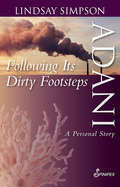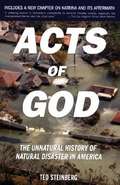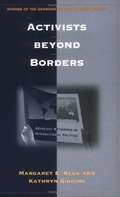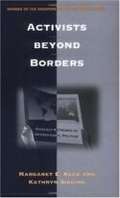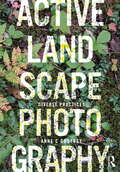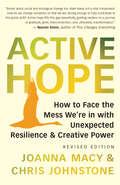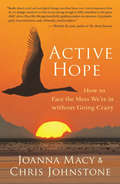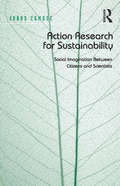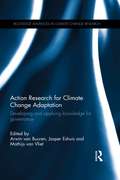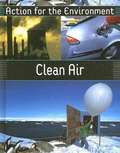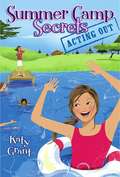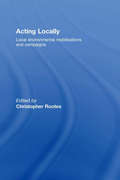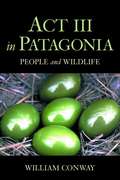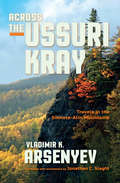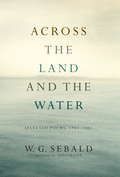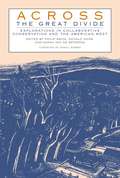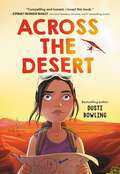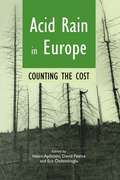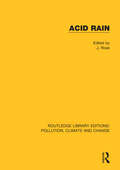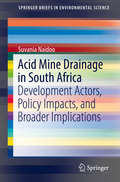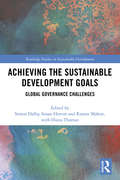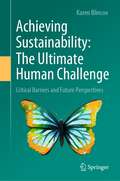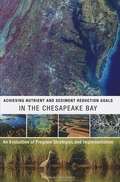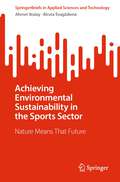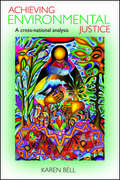- Table View
- List View
Adani, Following Its Dirty Footsteps: A Personal Story
by Lindsay SimpsonAdani’s license to mine 60 million tonnes of coal for 60 years threatens Australia’s precious ancient source of groundwater in the Galillee Basin, a vast underground water reservoir, part of the Great Artesian Basin, occupying more than 20% of Australia. How could a company with a globally disastrous reputation for environmental destruction along with a dubious financial status woo an Australian Prime Minister, a State Premier and a handful of regional mayors to back a project to build Australia’s largest coalmine and the world’s largest coal terminal only kilometres from the Great Barrier Reef? This book documents the inconceivable story of how Australian governments abrogated their responsibilities to protect this world heritage icon; bypassing environmental safeguards, thereby irrevocably damaging Australia’s reputation as environmental steward of some of the world’s most valuable natural assets.
Acts of God: The Unnatural History of Natural Disaster in America (Second Edition)
by Ted SteinbergAs the waters of the Mississippi River and Lake Pontchartrain began to pour into New Orleans, people began asking the big question - could any of this have been avoided? How much of the damage from Hurricane Katrina was bad luck, and how much was poor city planning? Steinberg's Acts of God is a provocative history of natural disasters in the United States. This revised edition features a new chapter analyzing the failed response to Hurricane Katrina, a disaster Steinberg warnedcould happen when the book first was published. Focusing on America's worst natural disasters, Steinberg argues that it is wrong to see these tragedies as random outbursts of nature's violence or expressions of divine judgment. He reveals how the decisions of business leaders and government officials have paved the way for the greater losses of life and property, especially among those least able to withstand such blows - America's poor, elderly, and minorities. Seeing nature or God as the primary culprit, Steinberg explains, has helped to hide the fact that some Americans are simply better able to protect themselves from the violence of nature than others. In the face of revelations about how the federal government mishandled the Katrina calamity, this book is a must-read before further wind and water sweep away more lives. Acts of God is a call to action that needs desperately to be heard.
Activists Beyond Borders: Advocacy Networks in International Politics
by Margaret E. Keck Kathryn SikkinkSurvey of non-governmental organizations' role in pressing for improvements in areas such as human rights, environmental stewardship and more.
Activists beyond Borders
by Margaret E. Keck Kathryn SikkinkA masterful combination of emerging theory and empirical comparison of one of the most intriguing areas of transnational politics. Keck and Sikkink access a broad range of theory from social movements, international relations, and comparative politics research to glean from a wealth of their own research findings solid and thought-provoking conclusions about the most interesting and least well-understood area of contentious politics in the world today. -Sidney Tarrow, Cornell University (Government) "Activists beyond Borders is a searching exploration of advocacy networks, providing compelling accounts in areas such as human rights and environmental protection and an intriguing glimpse into the transnational politics of the twenty-first century. "-Robert O. Keohane, Duke University Margaret E. Keck and Kathryn Sikkink examine a type of pressure group that has been largely ignored by political analysts: networks of activists that coalesce and operate across national frontiers. Their targets may be international organizations or the policies of particular states. Historical examples of such transborder alliances include anti-slavery and woman suffrage campaigns. In the past two decades, transnational activism has had a significant impact in human rights, especially in Latin America, and advocacy networks have strongly influenced environmental politics as well. The authors also examine the emergence of an international campaign around violence against women.
Active Landscape Photography: Diverse Practices (Active Landscape Photography)
by Anne C GodfreyDiverse Practices, the third book in the Active Landscape Photography series, presents a set of unique photographic examples for site-specific investigations of landscape places. Contributed by authors across academia, practice and photography, each chapter serves as a rigorous discussion about photographic methods for the landscape and their underlying concepts. Chapters also serve as unique case studies about specific projects, places and landscape issues. Project sites include the Miller Garden, Olana, XX Miller Prize and the Philando Castile Peace Garden. Landscape places discussed include the archeological landscapes of North Peru, watery littoral zones, the remote White Pass in Alaska, Sau Paulo and New York City’s Chinatown. Photographic image-making approaches include the use of lidar, repeat photography, collage, mapping, remote image capture, portraiture, image mining of internet sources, visual impact assessment, cameraless photography, transect walking and interviewing. These diverse practices demonstrate how photography, when utilized through a set of specific critical methods, becomes a rich process for investigating the landscape. Exploring this concept in relationship to specific contemporary sties and landscape issues reveals the intricacy and subtlety that exists when photography is used actively. Practitioners, academics, students and researchers will be inspired by the underlying concepts of these examples and come away with a better understanding about how to create their own rigorous photographic practices.
Active Hope (revised): How to Face the Mess We’re in with Unexpected Resilience and Creative Power
by Joanna Macy Chris JohnstoneThe challenges we face can be difficult even to think about. Climate change, war, political polarization, economic upheaval, and the dying back of nature together create a planetary emergency of overwhelming proportions. This revised, tenth anniversary edition of Active Hope shows us how to strengthen our capacity to face these crises so that we can respond with unexpected resilience and creative power. Drawing on decades of teaching an empowerment approach known as the Work That Reconnects, the authors guide us through a transformational process informed by mythic journeys, modern psychology, spirituality, and holistic science. This process equips us with tools to face the mess we’re in and play our role in the collective transition, or Great Turning, to a life-sustaining society.
Active Hope
by Joanna Macy Chris JohnstoneThe challenges we face can be difficult even to think about. Climate change, the depletion of oil, economic upheaval, and mass extinction together create a planetary emergency of overwhelming proportions. Active Hope shows us how to strengthen our capacity to face this crisis so that we can respond with unexpected resilience and creative power. Drawing on decades of teaching an empowerment approach known as the Work That Reconnects, the authors guide us through a transformational process informed by mythic journeys, modern psychology, spirituality, and holistic science. This process equips us with tools to face the mess we're in and play our role in the collective transition, or Great Turning, to a life-sustaining society.
Action Research for Sustainability: Social Imagination Between Citizens and Scientists
by Jonas EgmoseHow can action research further new research orientations towards sustainability? This book, empirically situated in the field of upstream public engagement, involving local residents, researchers and practitioners in bottom-up processes deliberating on urban sustainability, answers this question by analysing processes of social learning. The book addresses the need to move towards sustainability at societal level as a democratic challenge questioning the way we live on planet earth. By conceptualising sustain-ability as an immanent and emergent ability of ecological and social life, continuously to renew itself without eroding its own foundation of existence, it argues that since sustainability cannot be invented but only supported (or eroded) by science, we need to reframe science in the role of sustaining sustain-ability. Through analyses of a three year action research programme, aiming to provide local citizens with a greater say in the future of urban sustainability research, this book shows how action research can make important methodological contributions to processes of social learning between citizens and scientists by enabling free spaces in peoples everyday life and within academia, where aspects of un-sustainability can be addressed and new imaginations of more sustainable futures emerge.
Action Research for Climate Change Adaptation: Developing and applying knowledge for governance (Routledge Advances in Climate Change Research)
by Arwin Van Buuren Jasper Eshuis Mathijs Van VlietGovernments all over the world are struggling with the question of how to adapt to climate change. They need information not only about the issue and its possible consequences, but also about feasible governance strategies and instruments to combat it. At the same time, scientists from different social disciplines are trying to understand the dynamics and peculiarities of the governance of climate change adaptation. This book demonstrates how action-oriented research methods can be used to satisfy the need for both policy-relevant information and scientific knowledge. Bringing together eight case studies that show inspiring practices of action research from around the world, including Australia, Denmark, Vietnam and the Netherlands, the book covers a rich variety of action-research applications, running from participatory observation to serious games and role-playing exercises. It explores many adaptation challenges, from flood-risk safety to heat stress and freshwater availability, and draws out valuable lessons about the conditions that make action research successful, demonstrating how scientific and academic knowledge can be used in a practical context to reach useful and applicable insights. The book will be of interest to scholars and students of climate change, environmental policy, politics and governance.
Action for the Environment: Clean Air
by Rufus BellamyAction for the Environment. All around the world today, people are taking Action for the Environment. From small, local projects to large, global initiatives, people are finding ways to help prevent environmental damage. This new series helps build a foundation for a sustainable future by looking at: THE KEY ENVIRONMENTAL ISSUES, SOLUTIONS TO THE PROBLEMS, WHAT WE CAN DO TO HELP. Other titles in the series: Garbage Disposal, Water Supplies, Saving Wildlife, Energy Supplies, Transportation Solutions, Protecting Habitats, Food for All.
Acting Out (Summer Camp Secrets #2)
by Katy GrantThis was it. I was about to leave my past behind me and start my new life. All I had to do was say good-bye to my family and get on the bus. My mom clutched my arm. "Promise me you'll wear your headgear," she said, loud enough for twenty people to hear. Was that the most important thing she had to say to me before I left for a whole month?
Acting Locally: Local Environmental Mobilizations and Campaigns (Environmental Politics)
by Christopher RootesLocal campaigns are the most persistent and ubiquitous forms of environmental contention. National and transnational mobilisations come and go and the attention they receive from mass media ebbs and flows, but local campaigns persist. The persistence or re-emergence of local campaigns is also a reminder that it remain possible to mobilise people around environmental issues, and they have often served as sources of innovation in and re-invigoration of national organisations that have allegedly been co-opted by the powerful and incorporated into the established political and administrative system. But local environmental campaigns have been relatively neglected in the scientific literature. Drawing on examples from Britain, France, Greece, Ireland and Italy, this book seeks to redress that neglect by examining the networks among actors and organisations that connect local mobilizations to the larger environmental movement and political systems, the ways in which local disputes are framed in order to connect with national and global issues, and the persistent impacts of the peculiarities of place upon environmental campaigns. This book was previously published as a special issue of Environmental Politics
Act III in Patagonia: People and Wildlife
by William ConwayFrom tracking elephant seals in the Atlantic to following flamingos in the Andes, Act III in Patagonia takes readers to the sites where real-life field science is taking place. It further illuminates the ecology of the region through a history that reaches from the time of the Tehuelche Indians known by Magellan, Drake, and Darwin to the present.
Across the Ussuri Kray: Travels in the Sikhote-Alin Mountains
by Vladimir K. Arsenyev Ivan Yegorchev Jonathan C. SlaghtIn Russia's Far East sits the wild Ussuri Kray, a region known for its remote highlands and rugged mountain passes where tigers and bears roam the cliffs, and salmon and lenok navigate the rivers. In this collection of travel writing by famed Russian explorer and naturalist Vladimir K. Arsenyev (1872-1930), readers are shuttled back to the turn of the 20th century when the Russian Empire was reeling from its defeat in the Russo-Japanese War (1904-1905) and vulnerable to its Far Eastern neighbors. What began as an expedition to survey the region's infrastructure for the Russian military turned into an adventure through one of the most ethnically and ecologically diverse territories on the continent. Encountering the disappearing indigenous cultures of the Nanai and Udege, engaging the help of Korean farmers and Chinese hunters, and witnessing the beginning of indomitable Russian settlement, Arsenyev documents the lives and customs of the region's inhabitants and their surroundings. Originally written as "a popular scientific description of the Kray," this unabridged edition includes photographs largely unseen for nearly a century and is annotated by Jonathan C. Slaght, a biologist working in the same forests Arsenyev explored. Across the Ussuri Kray is a classic of northeast Asian cultural and natural history.
Across the Land and the Water
by W. G. SebaldA publishing landmark--the first major collection of poems by one of the late twentieth century's literary masters German-born W. G. Sebald is best known as the innovative author of Austerlitz, the prose classic of World War II culpability and conscience that The Guardian called "a new literary form, part hybrid novel, part memoir, part travelogue." Its publication put Sebald in the company of Nabokov, Calvino, and Borges. Yet Sebald's brilliance as a poet has been largely unacknowledged--until now. Skillfully translated by Iain Galbraith, the nearly one hundred poems in Across the Land and the Water range from those Sebald wrote as a student in the sixties to those completed right before his untimely death in 2001. Featuring eighty-eight poems published in English for the first time and thirty-three from unpublished manuscripts, this collection also brings together all the verse he placed in books and journals during his lifetime. Here are Sebald's trademark themes--from nature and history ("Events of war within/a life cracks/across the Order of the World/spreading from Cassiopeia/a diffuse pain reaching into/the upturned leaves on the trees"), to wandering and wondering ("I have even begun/to speak in foreign tongues/roaming like a nomad in my own/town . . ."), to oblivion and memory ("If you knew every cranny/of my heart/you would yet be ignorant/of the pain my happy/memories bring"). Soaring and searing, the poetry of W. G. Sebald is an indelible addition to his superb body of work, and this unique collection is bound to become a classic in its own right.From the Hardcover edition.
Across the Great Divide: Explorations In Collaborative Conservation And The American West
by Daniel Kemmis Sarah F. Bates Philip Brick Donald SnowAmid the policy gridlock that characterizes most environmental debates, a new conservation movement has emerged. Known as "collaborative conservation," it emphasizes local participation, sustainability, and inclusion of the disempowered, and focuses on voluntary compliance and consent rather than legal and regulatory enforcement. Encompassing a wide range of local partnerships and initiatives, it is changing the face of resource management throughout the western United States.Across the Great Divide presents a thoughtful exploration of this new movement, bringing together writing, reporting, and analysis of collaborative conservation from those directly involved in developing and implementing the approach. Contributors examine: the failure of traditional policy approaches recent economic and demographic changes that serve as a backdrop for the emergence of the movement the merits of, and drawbacks to, collaborative decision-making the challenges involved with integrating diverse voices and bringing all sectors of society into the movement .In addition, the book offers in-depth stories of eight noteworthy collaborative initiatives -- including the Quincy Library Group, Montana's Clark Fork River, the Applegate Partnership, and the Malpai Borderlands -- that explore how different groups have organized and acted to implement their goals.Among the contributors are Ed Marston, George Cameron Coggins, David Getches, Andy Stahl, Maria Varela, Luther Propst, Shirley Solomon, William Riebsame, Cassandra Moseley, Lynn Jungwirth, and others. Across the Great Divide is an important work for anyone involved with collaborative conservation or the larger environmental movement, and for all those who care about the future of resource management in the West.
Across the Desert
by Dusti BowlingOne girl sets out on a journey across the treacherous Arizona desert to rescue a young pilot stranded after a plane crash in this gripping story of survival, friendship, and rescue from a bestselling and award-winning author.Twelve-year-old Jolene spends every day she can at the library watching her favorite livestream: The Desert Aviator, where twelve-year-old &“Addie Earhart&” shares her adventures flying an ultralight plane over the desert. While watching this daring girl fly through the sky, Jolene can dream of what it would be like to fly with her, far away from her own troubled home life where her mother struggles with a narcotic addiction. And Addie, who is grieving the loss of her father, finds solace in her online conversations with Jolene, her biggest—and only—fan.Then, one day, it all goes wrong: Addie's engine abruptly stops, and Jolene watches in helpless horror as the ultralight plummets to the ground and the video goes dark. Jolene knows that Addie won&’t survive long in the extreme summer desert heat. With no one to turn to for help and armed with only a hand-drawn map and a stolen cell phone, it's up to Jolene to find a way to save the Desert Aviator. Packed with adventure and heart, Across the Desert speaks to the resilience, hope, and strength within each of us.
Acid Rain in Europe: Counting the cost (Earthscan Library Collection: International Environmental Governance Set Ser.)
by David Pearce Helen ApSimon Ece ÖzdemirogluThe environmental impacts of acid rain: on human health, on buildings and materials, on forests, freshwaters, crops and biodiversity and on global warming have been well-documented. Less is known about the extent and economic costs of these impacts. This book describes the first major implementation of an integrated scientific and economic assessment of the consequences of acid rain. It provides an extensive data review and examines how this unique approach to assessment modelling can be can be used to calculate an acidification cost per unit of pollutant in monetary terms. Part One focuses on the methodological issues of scientific measurement of acidification, dose-response relationships and economic approaches to acidification control. Part Two looks at the environmental impacts and economic consequences of acidification. Affected environmental media and human health are investigated in separate chapters, each including both scientific and economic analyses. Part Three provides a summary of the findings and makes recommendations for further application of these types of results to policy actions.
Acid Rain
by J. RoseOriginally published in 1994 this volume includes contributions from environmental scientists, consultants and research workers. The incidence and effects of the phenomenon of acid rain in the late 1970s, 80s and early 1990s , as well as certain remedies, are discussed at length. The roles of vehicles and power stations are examined in detail and legal aspects of curbing acid rain are considered.
Acid Mine Drainage in South Africa: Development Actors, Policy Impacts, and Broader Implications (SpringerBriefs in Environmental Science)
by Suvania NaidooThis SpringerBrief focuses on Acid Mine Drainage (AMD) in the three basins in the Witwatersrand, South Africa. It provides a background to AMD and its impactsfrom a social science perspective. The South African government and non-governmental organizations' response to AMD is assessed, as well the socio-economic and developmental effects of AMD. This volume, which is based on the author's Master's dissertation at UNISA, involves interviews with a range of experts in the field from government departments, environmental organisations (activists), the private sector (mining), tourism sector and the agricultural sector. The book discusses existing policy documents on AMD and provides recommendations in response to the many socio-economic impacts which have not been fully addressed. A literature review on the global context of AMD is provided. South Africa's water systems are already severely harmed by climate change, different forms of pollution, and poorly managed sanitation systems. For these reasons, the country is becoming increasingly water-stressed and therefore, water will continue to become much scarcer in the future. As a result of AMD's continued impact on South Africa's water systems, as a technical or scientific matter as well as the policy implications for the mining sector, water security and socio-economic sustainability has become a highly contested issue.
Achieving the Sustainable Development Goals: Global Governance Challenges (Routledge Studies in Sustainable Development)
by Simon Dalby Susan Horton Rianne Mahon Diana ThomazThis book draws on the expertise of faculty and colleagues at the Balsillie School of International Affairs to both locate the Sustainable Development Goals (SDGs) as a contribution to the development of global government and to examine the political-institutional and financial challenges posed by the SDGs. The contributors are experts in global governance issues in a broad variety of fields ranging from health, food systems, social policy, migration and climate change. An introductory chapter sets out the broad context of the governance challenges involved, and how individual chapters contribute to the analysis. The book begins by focusing on individual SDGs, examining briefly the background to the particular goal and evaluating the opportunities and challenges (particularly governance challenges) in achieving the goal, as well as discussing how this goal relates to other SDGs. The book goes on to address the broader issues of achieving the set of goals overall, examining the novel financing mechanisms required for an enterprise of this nature, the trade-offs involved (particularly between the urgent climate agenda and the social/economic goals), the institutional arrangements designed to enable the achievement of the goals and offering a critical perspective on the enterprise as a whole. Achieving the Sustainable Development Goals makes a distinctive contribution by covering a broad range of individual goals with contributions from experts on governance in the global climate, social and economic areas as well as providing assessments of the overall project – its financial feasibility, institutional requisites, and its failures to tackle certain problems at the core. This book will be of great interest to scholars and students of international affairs, development studies and sustainable development, as well as those engaged in policymaking nationally, internationally and those working in NGOs.
Achieving Sustainability: Critical Barriers and Future Perspectives
by Karen BlincoeThe book provides an assessment of whether sustainability is realizable in the current societal framework. What are the challenges and the barriers - and what are the levers necessary to meet and overcome them?Through a revision of the essence of sustainability the book provides an opportunity to understand the deeper level of the radical change that sustainability represents, and the resistance that is preventing its realization.To build the argument the sustainable development model is compared with current development theories as well as alternative solutions based on utopian models of the past. The book assesses the results that can be achieved within the current systemic framework, based on case stories. It outlines the limitations to sustainability, pointing out and defining the multiple, cross-sectoral and systemic barriers that hinder the transition.Finally, the book offers perspectives on achieving a sustainable future, encompassing the impacts from recent events including the pandemic as well as the multiple mitigation and transition initiatives undertaken globally.Brian Goodwin's QuoteLike the caterpillar that wraps itself up in its silken swaddling bands prior to its metamorphosis into a butterfly, we have wrapped ourselves in a tangled skin from which we can emerge only by going through a similarly dramatic transformation.
Achieving Nutrient and Sediment Reduction Goals in the Chesapeake Bay: An Evaluation of Program Strategies and Implementation
by The National Academy of SciencesThe Chesapeake Bay is North America's largest and most biologically diverse estuary, as well as an important commercial and recreational resource. However, excessive amounts of nitrogen, phosphorus, and sediment from human activities and land development have disrupted the ecosystem, causing harmful algae blooms, degraded habitats, and diminished populations of many species of fish and shellfish. In 1983, the Chesapeake Bay Program (CBP) was established, based on a cooperative partnership among the U. S. Environmental Protection Agency (EPA), the state of Maryland, and the commonwealths of Pennsylvania and Virginia, and the District of Columbia, to address the extent, complexity, and sources of pollutants entering the Bay. In 2008, the CBP launched a series of initiatives to increase the transparency of the program and heighten its accountability and in 2009 an executive order injected new energy into the restoration. In addition, as part of the effect to improve the pace of progress and increase accountability in the Bay restoration, a two-year milestone strategy was introduced aimed at reducing overall pollution in the Bay by focusing on incremental, short-term commitments from each of the Bay jurisdictions. The National Research Council (NRC) established the Committee on the Evaluation of Chesapeake Bay Program Implementation for Nutrient Reduction in Improve Water Quality in 2009 in response to a request from the EPA. The committee was charged to assess the framework used by the states and the CBP for tracking nutrient and sediment control practices that are implemented in the Chesapeake Bay watershed and to evaluate the two-year milestone strategy. The committee was also to assess existing adaptive management strategies and to recommend improvements that could help CBP to meet its nutrient and sediment reduction goals. The committee did not attempt to identify every possible strategy that could be implemented but instead focused on approaches that are not being implemented to their full potential or that may have substantial, unrealized potential in the Bay watershed. Because many of these strategies have policy or societal implications that could not be fully evaluated by the committee, the strategies are not prioritized but are offered to encourage further consideration and exploration among the CBP partners and stakeholders.
Achieving Environmental Sustainability in the Sports Sector: Nature Means That Future (SpringerBriefs in Applied Sciences and Technology)
by Ahmet Atalay Biruta ŠvagždienėThis book explores the previously overlooked negative environmental impact of the sports industry, with a particular emphasis on the carbon footprint of sports facilities and organizations. The authors provide a comprehensive assessment of sustainable development goals, economic, social, and environmental sustainability concepts. They reveal the significant negative effects that the sports sector has on the environment and examine the policies implemented by stakeholders in the industry.The book also explores a case study of the legal policies implemented by the Lithuanian government to reduce the environmental impact of sports. The authors present practical suggestions for environmentally-friendly sports management, supported by examples presented with figures, pictures, and tables.This book fills a gap in the literature, offering suggestions and comments to enrich the practices of stakeholders in the sports industry. It provides an opportunity to make a positive difference for the environment while advancing the field of sports management.
Achieving Environmental Justice: A Cross-National Analysis
by Karen BellEnvironmental justice aspires to a healthy environment for all, as well as fair and inclusive processes of environmental decision-making. In order to develop successful strategies to achieve this, it is important to understand the factors that shape environmental justice outcomes. This optimistic, accessible and wide-ranging book contributes to this understanding by assessing the extent of, and reasons for, environmental justice/injustice in seven diverse countries - United States, Republic of Korea (South Korea), United Kingdom, Sweden, China, Bolivia and Cuba. Factors discussed include: race and class discrimination; citizen power; industrialisation processes; political-economic context; and the influence of dominant environmental discourses. In particular, the role of capitalism is critically explored. Based on over a hundred interviews with politicians, experts, activists and citizens of these countries, this is a compelling analysis aimed at all academics, policy-makers and campaigners who are engaged in thinking or action to address the most urgent environmental and social issues of our time.
